Fluorescence quantitative PCR (qPCR) : based on conventional PCR, “probe for mycoplasma specific conserved sequence” is labeled with fluorescence to make PCR amplified products with fluorescence, and the change of fluorescence signal and supporting software are used to carry out real-time monitoring of DNA amplification reaction, referred to as qPCR.
Advantages:
① High sensitivity and specificity.
② The time is short, 2-3 hours to produce the results.
③ The detection results can be quantified.
④ Easy to operate.
Disadvantages:
① For the samples that have been inactivated with mycoplasma, the PCR results will be false positive because the MYCOplasma DNA still exists in the samples. (Culture method can be used for supplementary verification)
② The quality of kits produced by different manufacturers varies greatly (due to different primers and internal design), so it is necessary to choose carefully and use them as recommended by professionals as possible.
History of PCR technology
1953 — The structural basis of DNA
The double helix model of DNA published by Watson and Crick marked the birth of molecular biology, which is regarded as the greatest biological discovery of the 20th century [1]. Since then, humans have been exploring new ways and techniques to study DNA.
1971 – PCR prototype
Khorana successfully synthesized the first gene — alanine tRNA encoding gene [2]. Kleppe proposed in vitro amplification [3]. However, due to the limited technology level at that time, and the DNA polymerase with strong stability has not been discovered, DNA amplification technology in vitro has not been fully promoted.
1985 – PCR technique was first proposed
Mullis described the epoch-making PCR technology [4]. The principle is similar to DNA replication in vivo, but in a test tube provides the right conditions for in vitro synthesis – template DNA, oligonucleotide primers, dNTP, DNA polymerase, suitable buffer system, temperature and time for DNA denaturation, renaturation and extension. The Klenow fragment of E. coli DNA polymerase originally used was not heat resistant and had to be re-added after each heat treatment to denature the DNA. Time-consuming, laborious and error-prone.
1988 — Optimization of PCR technology
Saiki et al. extracted a high-temperature resistant DNA polymerase from a strain of Thermus aquaticus (Taq) isolated from hot springs in Yellowstone Park [5]. The high temperature resistance of the enzyme prevents it from being passivated during thermal denaturation, and it is unnecessary to add a new enzyme after each amplification reaction, thus greatly improving the efficiency of PCR amplification. The discovery of Taq made PCR a reality, paving the way for its automation.
1989 – PCR explosion
The US magazine Science named PCR as the “molecule of the Year” for the heat-stabilized DNA polymerase as the first of more than a dozen scientific inventions.
1993 — Nobel Prize
Dr. Kary Banks Mullis won the Nobel Prize in Chemistry for PCR.
Principle of PCR technology
A PCR cycle consists of denaturation – annealing – extension:
First, denatured and unchained DNA template was heated at high temperature. The reaction mixture is then cooled to a temperature at which the primer can be annealed with its target sequence. The annealing primers could be extended by DNA polymerase by increasing the temperature.
Repeating the cycle, the target DNA was amplified by a factor of 2N in just a few minutes.
PCR reaction diagram

PCR is widely used in life science, medical diagnosis, forensic detection, food hygiene and environmental detection due to its high sensitivity and high efficiency in the amplification of target DNA.
With the exploration of genetic information, PCR gene detection technology has achieved unprecedented development. According to different detection purposes and characteristics, PCR technology has been gradually subdivided into the second generation PCR technology (semi-quantitative detection) and the third generation PCR technology (absolute quantitative detection). At the same time, first-generation DNA sequencing technologies (read length, high accuracy, low throughput) and second-generation DNA sequencing technologies (read length, high throughput) have also been invented and widely used. Starting next week, GeneThinkTank will take you on a journey to discover some of the most important genetic testing technologies from scratch.


